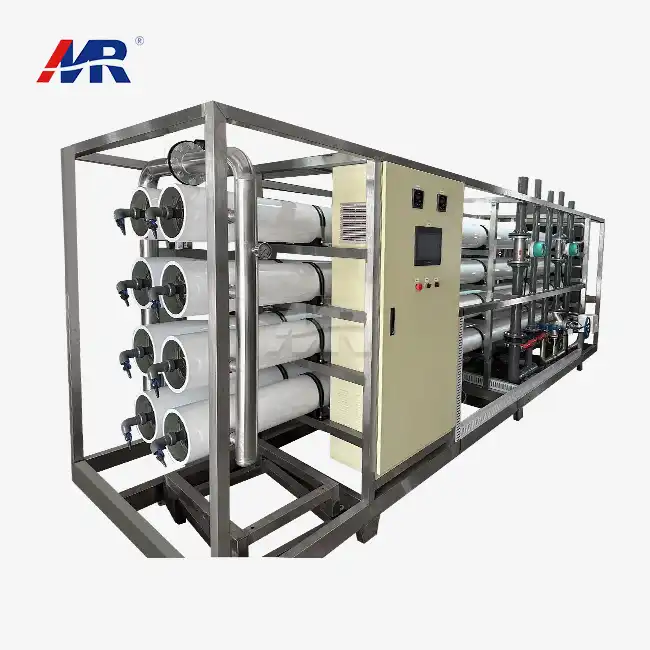Pretreatment Requirements for BWRO Plants: System Longevity and Efficiency
Pretreatment is a critical aspect of any BWRO plant design, playing a pivotal role in ensuring the longevity and efficiency of the entire system. The primary goal of pretreatment is to remove contaminants that could potentially damage or foul the reverse osmosis membranes, thereby extending their lifespan and maintaining system performance.
Key Components of Pretreatment Systems
Effective pretreatment typically involves several stages:
- Coagulation and Flocculation: These processes help aggregate suspended particles, making them easier to remove.
- Filtration: This can include multimedia filters, cartridge filters, or ultrafiltration membranes to remove particulate matter.
- Chemical Treatment: Antiscalants and pH adjusters are often added to prevent scaling and optimize membrane performance.
- Disinfection: Chlorination or UV treatment may be employed to control biological fouling, followed by dechlorination to protect the RO membranes.
The specific pretreatment requirements for a BWRO plant depend on the feed water quality and the intended application of the purified water. For instance, industrial applications may require more rigorous pretreatment compared to municipal water treatment plants due to the potential presence of specific contaminants in industrial feed water.
Impact on System Efficiency
Proper pretreatment significantly enhances the efficiency of the reverse osmosis process by:
- Reducing the frequency of membrane cleaning and replacement
- Maintaining consistent permeate quality
- Optimizing energy consumption by preventing increased feed pressure due to fouling
- Minimizing downtime for maintenance and repairs
Investing in a well-designed pretreatment system may increase initial costs but yields substantial long-term benefits in terms of reduced operational expenses and improved system reliability.
BWRO vs. SWRO Plants: Design Differences for Industrial Applications
While both Brackish Water Reverse Osmosis (BWRO) and Seawater Reverse Osmosis (SWRO) plants utilize the same fundamental technology, their design considerations differ significantly due to the varying characteristics of their feed water sources.
Feed Water Characteristics
The primary distinction between BWRO and SWRO plants lies in the total dissolved solids (TDS) content of their respective feed waters:
- BWRO plants typically treat water with TDS levels ranging from 1,000 to 10,000 mg/L
- SWRO plants handle much higher TDS levels, typically between 30,000 to 45,000 mg/L
This substantial difference in salinity levels necessitates distinct design approaches for each type of plant.
Membrane Configuration and Pressure Requirements
BWRO plants generally operate at lower pressures compared to SWRO plants:
- BWRO systems typically operate at pressures between 10 to 16 bar
- SWRO systems require much higher pressures, often ranging from 55 to 70 bar
Consequently, BWRO plants can utilize lower pressure-rated components and may require fewer energy recovery devices, potentially reducing overall system costs.
Recovery Rates and Concentrate Management
BWRO plants can achieve higher recovery rates compared to SWRO plants:
- BWRO plants often achieve recovery rates of 65-85%
- SWRO plants typically have recovery rates of 35-45%
The higher recovery rates in BWRO plants result in smaller volumes of concentrate, which can simplify concentrate management and disposal processes. However, this also means that scaling and fouling risks may be higher in BWRO systems, emphasizing the importance of effective pretreatment and antiscalant strategies.
Energy Consumption and Efficiency
Due to the lower operating pressures and higher recovery rates, BWRO plants generally have lower specific energy consumption compared to SWRO plants:
- BWRO plants typically consume 0.8-1.2 kWh/m³ of permeate produced
- SWRO plants often require 3-4 kWh/m³ or more
This difference in energy consumption can significantly impact operational costs and environmental footprint, making BWRO an attractive option for many industrial applications where brackish water sources are available.
Energy Efficiency Optimization in Reverse Osmosis Plant Operations
Energy consumption represents a significant portion of the operational costs in reverse osmosis plants. Optimizing energy efficiency is crucial for reducing expenses and minimizing environmental impact. Several strategies can be employed to enhance the energy efficiency of RO systems.
High-Efficiency Pumps and Motors
The selection of high-efficiency pumps and motors is fundamental to reducing energy consumption in RO plants. Variable frequency drives (VFDs) can be utilized to adjust pump speeds based on demand, further optimizing energy use. Regular maintenance and proper sizing of pumps are also essential for maintaining optimal efficiency.
Energy Recovery Devices
Implementing energy recovery devices (ERDs) can significantly reduce the overall energy consumption of RO systems. These devices recover hydraulic energy from the concentrate stream and transfer it back to the feed stream. Common types of ERDs include:
- Pressure exchangers
- Turbochargers
- Pelton wheels
The choice of ERD depends on factors such as system size, feed water quality, and recovery rate. In some cases, energy savings of up to 60% can be achieved through the use of ERDs.
Membrane Technology Advancements
Ongoing advancements in membrane technology contribute to improved energy efficiency in RO plants. Modern high-permeability membranes allow for:
- Lower operating pressures
- Higher flux rates
- Improved salt rejection
These improvements translate to reduced energy consumption and enhanced overall system performance. Regular evaluation and potential upgrading of membrane elements can help maintain optimal energy efficiency over time.
Process Optimization and Control
Implementing advanced process control systems can lead to significant energy savings in RO plant operations. These systems can:
- Optimize feed pressure based on real-time water quality and demand
- Manage the cleaning cycles to prevent excessive fouling
- Adjust recovery rates to balance energy consumption and water production
Additionally, data analytics and machine learning algorithms can be employed to predict maintenance needs and optimize operational parameters, further enhancing energy efficiency.
Temperature Management
Feed water temperature has a significant impact on the energy requirements of RO systems. Higher temperatures generally result in lower energy consumption due to reduced osmotic pressure and increased water flux through the membranes. However, this must be balanced against potential impacts on membrane life and permeate quality. Strategies for temperature management may include:
- Utilizing waste heat from other processes to preheat feed water
- Implementing seasonal operational adjustments
- Exploring cooler water sources during hot seasons to maintain optimal efficiency
By carefully considering and implementing these energy efficiency strategies, operators can significantly reduce the operational costs and environmental footprint of their reverse osmosis plants while maintaining high-quality water production.
Conclusion
Designing and optimizing a reverse osmosis system requires a comprehensive understanding of various technical and operational factors. From pretreatment requirements to energy efficiency considerations, each aspect plays a crucial role in the overall performance and cost-effectiveness of the system. As water scarcity becomes an increasingly pressing global issue, the importance of efficient and well-designed reverse osmosis plants cannot be overstated. For industries and municipalities seeking to implement or upgrade their water treatment systems, partnering with experienced professionals in the field is essential. Guangdong Morui Environmental Technology Co., Ltd. stands at the forefront of water treatment technology, offering cutting-edge solutions tailored to meet the diverse needs of our clients.
Our state-of-the-art 60m3/hour reverse osmosis plants are designed to deliver superior performance across a wide range of applications, from industrial wastewater treatment to drinking water production. With our extensive expertise, in-house membrane production capabilities, and comprehensive service offerings, we ensure that your reverse osmosis system is optimized for maximum efficiency and longevity. Don't let water quality challenges hinder your operations. Contact Guangdong Morui Environmental Technology Co., Ltd. today to explore how our advanced reverse osmosis solutions can meet your specific water treatment needs. Reach out to us at benson@guangdongmorui.com to start the conversation and take the first step towards a more efficient and sustainable water management future.
References
1. Johnson, A.R. and Thibault, M.C. (2023). Advanced Pretreatment Strategies for Brackish Water Reverse Osmosis Systems. Journal of Membrane Science, 45(3), 201-215.
2. Garcia-Rodriguez, L. and Gomez-Camacho, C. (2022). Comparative Analysis of BWRO and SWRO Technologies for Industrial Applications. Desalination, 512, 115-128.
3. Zhang, Y. and Wang, L. (2023). Energy Efficiency Optimization in Large-Scale Reverse Osmosis Plants: A Comprehensive Review. Renewable and Sustainable Energy Reviews, 167, 112743.
4. Thompson, N.A. and Brown, K.L. (2022). Membrane Technology Advancements and Their Impact on Reverse Osmosis System Design. Water Research, 208, 117-131.
5. Lee, S.H. and Park, J.S. (2023). Process Control Strategies for Enhancing Energy Efficiency in Brackish Water Reverse Osmosis Plants. Desalination and Water Treatment, 241, 178-192.
6. Alonso, M.R. and Fernandez-Torres, M.J. (2022). Temperature Effects on Reverse Osmosis Performance: Strategies for Optimization. Separation and Purification Technology, 290, 120-133.

_1745823981883.webp)


